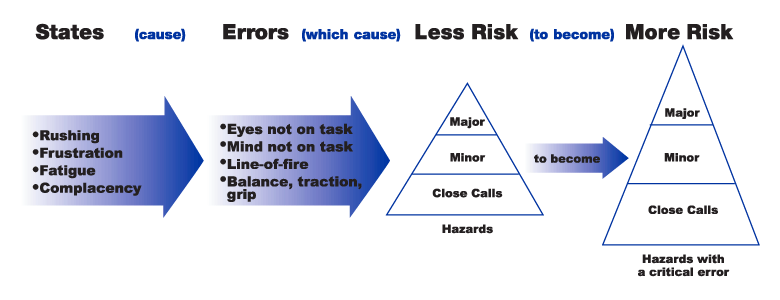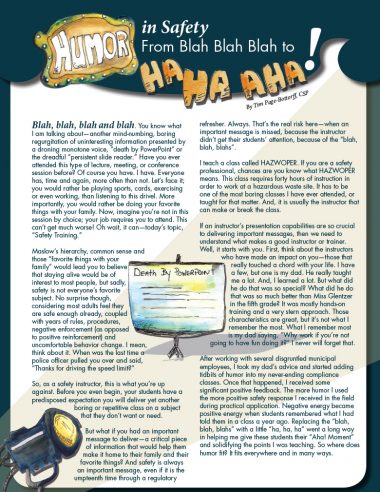By Tim Page-Bottorff, CSP, CIT
Blah, blah, blah and blah.
You know what I am talking about—another mind-numbing, boring regurgitation of uninteresting information presented by a droning monotone voice, “death by PowerPoint” or the dreadful “persistent slide reader.” Have you ever attended this type of lecture, meeting, or conference session before? Of course you have. I have. Everyone has, time and again, more often than not. Let’s face it; you would rather be playing sports, cards, exercising or even working, than listening to this drivel. More importantly, you would rather be doing your favorite things with your family. Now, imagine you’re not in this session by choice; your job requires you to attend. This can’t get much worse! Oh wait, it can—today’s topic, “Safety Training.”
Maslow’s hierarchy, common sense and those “favorite things with your family” would lead you to believe that staying alive would be of interest to most people, but sadly, safety is not everyone’s favorite subject. No surprise though, considering most adults feel they are safe enough already, coupled with years of rules, procedures, negative enforcement (as opposed to positive reinforcement) and uncomfortable behavior change. I mean, think about it. When was the last time a police officer pulled you over and said, “Thanks for driving the speed limit?”

So, as a safety instructor, this is what you’re up against. Before you even begin, your students have a predisposed expectation you will deliver yet another boring or repetitive class on a subject that they don’t want or need.
But what if you had an important message to deliver—a critical piece of information that would help them make it home to their family and their favorite things? And safety is always an important message, even if it is the umpteenth time through a regulatory refresher. Always. That’s the real risk here—when an important message is missed, because the instructor didn’t get their students’ attention, because of the “blah, blah, blahs”.
I teach a class called HAZWOPER. If you are a safety professional, chances are you know what HAZWOPER means. This class requires forty hours of instruction in order to work at a hazardous waste site. It has to be one of the most boring classes I have ever attended, or taught for that matter. And, it is usually the instructor that can make or break the class.
If an instructor’s presentation capabilities are so crucial to delivering important messages, then we need to understand what makes a good instructor or trainer. Well, it starts with you. First, think about the instructors who have made an impact on you—those that really touched a chord with your life. I have a few, but one is my dad. He really taught me a lot. And, I learned a lot. But what did he do that was so special? What did he do that was so much better than Miss Glentzer in the fifth grade? It was mostly hands-on training and a very stern approach. Those characteristics are great, but it’s not what I remember the most. What I remember most is my dad saying, “Why work if you’re not going to have fun doing it?” I never will forget that.
After working with several disgruntled municipal employees, I took my dad’s advice and started adding tidbits of humor into my never-ending compliance classes. Once that happened, I received some significant positive feedback. The more humor I used the more positive safety response I received in the field during practical application. Negative energy became positive energy when students remembered what I had told them in a class a year ago. Replacing the “blah, blah, blahs” with a little “ha, ha, ha” went a long way in helping me give these students their “Aha! Moment” and solidifying the points I was teaching. So where does humor fit? It fits everywhere and in many ways.
 Poking Fun (at Yourself)
Poking Fun (at Yourself)
First and foremost, you need to set the class at ease, let them know you’ve been in their shoes and provide selfdisclosure to the students. Open yourself a little. Letting the students know you are as human as they are can go a long way—especially if you can relate some humorous mistakes you’ve made and the lessons you’ve learned as a result. I teach a lot of SafeStart® classes, and one of its great successes is this self-disclosure component.
Finding Humor in Visuals
There are so many funny video clips, photos and cartoons in circulation now, you can fairly easily locate one that will serve as a valuable anecdote in your presentation. These visuals provide laughter, but with appropriate selection can also illustrate or support important teaching points—helping students relate, form more complete thoughts and retain the information better than without humor. A word of caution though: always select visuals that will be appropriate for your audience.
Fun and Games
Back to the HAZWOPER class I mentioned earlier. Other than the typical hands-on component that gets attached to a class of this magnitude, there are several other auxiliary items you can add to make it more upbeat or humorous. For example, play a game for reviewing test questions. There are several free PowerPoint®-based game templates like “Jeopardy”, “Who Wants to be a Millionaire” and “Family Feud” that lend themselves to this type of activity. They increase retention levels, participation and fun.
Another tactic I use during the Site Characterization component is to incorporate building toys, like Lego®, Lincoln Logs®, Tinkertoy® or K’nex®. Beyond the childhood memories and fun, these toys give the students an opportunity to “see” the Hot, Warm and Cold Zones inside before they have to build them outside.
Stories
As I touched on earlier, I teach a lot of SafeStart classes. SafeStart’s greatest ingredient is that it is filled with real people telling real stories about their real injuries. It even teaches participants how to tell their own SafeStart stories. And for good reason, these stories stick like glue. After providing consulting services for clients over several years, I can still remember my very first stories involving the State-to-Error Risk Pattern (Figure 1). Shoot! I can still remember stories told to me way back in 1976! The point I am trying to make is that stories can linger in a good way, and I often remember them when I’m doing similar activities and will modify my behavior to avoid the injury or close call that happened in the story I was told.

Figure 1
Start slow and build elements into your class. Especially with humor, practicing your delivery is essential. Like an actor on a stage, you need to hit your marks. You need to keep your audience on a roller coaster of emotions—laughing one minute, drop dead serious the next, followed by storied anticipation, then through a winding tunnel of selfdiscovery until they cheer for more when the ride is over. Ok, I might be optimistic about the cheering, but I bet you’d settle for attentiveness and a few smiles.
Just remember, it all starts with you. If I can leave you with one point it is this; the minute you get comfortable with your preparation, then it is time to do more work. Oh, and don’t forget the reason you are doing what you are doing. It isn’t about you, it’s about them, and if you do well by them in giving your students an enjoyable class, you will be rewarded yourself with an enjoyable class. Life is funny that way.
Feel the Love
Back to my dad for a minute—he has worked in many different fields after leaving the Air Force. He didn’t have one job he really enjoyed doing, but always found enjoyment in them. If you love what you do, you will LOVE what you do. You have a choice, and you can choose to find and focus on those things that you love. In safety it’s easy, saving one life and reducing injuries overshadows an awful lot of tiring or thankless work. How fortuitous is it that having fun at work can translate to having fun while training or learning? And if you’re passionate about safety, it will show in your presentation and it will become infectious among your students and your colleagues.

Figure 2
Average retention of material presented in different ways
(according to an investigation by National Training Laboratories — Bethel, Maine)
A Balancing Act
These are just a few ways to make training fun and impactful. Pick and choose the types that work for you, just try to avoid relying too heavily on any one thing. Too many videos will eventually become boring, just like too much lecture will, and too much comedy will almost certainly obscure or obliterate your important message.
Having fun is great, but you must know where to draw the line. I mean, you will always come back to the seriousness of safety—the whole reason why you are there in the first place—but finding a good balance of humorous or interesting activities to intersperse with the important messages you need to communicate will ultimately make for a memorable class. In fact, it has been proven time and again that using a combination of learning activities increases retention (Figure 2).
Tim Page-Bottorff, CSP, CET is a senior SafeStart consultant, past president of the ASSP Arizona Chapter and a former United States Marine. As an OSHA trainer he is well-versed in how to facilitate effective training sessions and he frequently speaks about training and other safety topics at national safety conferences.

Get the PDF version
You can download a printable PDF of the article using the button below.

